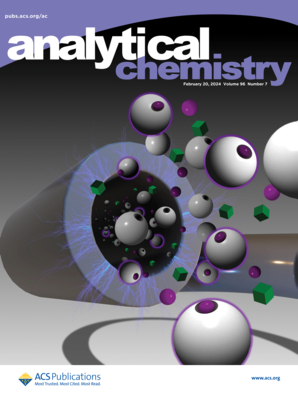硒基硫化键作为构建硫醇探针的通用支架,可提高响应速度
IF 6.7
1区 化学
Q1 CHEMISTRY, ANALYTICAL
引用次数: 0
摘要
本文章由计算机程序翻译,如有差异,请以英文原文为准。

Selenenylsulfide Bond as a General Scaffold for Constructing Thiol Probes with Enhanced Response Rate
Leveraging disulfide (−S–S−) or diselenide (−Se–Se−) units as triggers in the design of small-molecule fluorescent probes for detecting intracellular reductive species has demonstrated high efficacy. However, selenenylsulfides, which exhibit reactivity between diselenides and disulfides, remain relatively unexplored. In this work, we compare the efficiency of −S–S–, seleno-sulfur (−Se–S−), and sulfur–selenium (−S–Se−) structural units in constructing thiol probes, disclose the scaffold of −Se–S– as a versatile recognition site for thiols, and successfully apply this unit to design a near-infrared (NIR) probe, ASC-SeS. The mechanism reveals that breaking the −Se–S– bond leads to a selenolate, which undergoes faster cyclization than the corresponding thiolate that is from the cleavage of the −S–S– or −S–Se– bond. Conjugation of this trigger unit with multiple NIR fluorophores validates the general applicability of linear selenenylsulfides in accelerating the response rate to thiols. By harnessing the superior thiol responsiveness of ASC-SeS, we employ this probe in live cells and in vivo, and elucidate a severe depletion of thiols in the drug-induced liver injury (DILI).
求助全文
通过发布文献求助,成功后即可免费获取论文全文。
去求助
来源期刊

Analytical Chemistry
化学-分析化学
CiteScore
12.10
自引率
12.20%
发文量
1949
审稿时长
1.4 months
期刊介绍:
Analytical Chemistry, a peer-reviewed research journal, focuses on disseminating new and original knowledge across all branches of analytical chemistry. Fundamental articles may explore general principles of chemical measurement science and need not directly address existing or potential analytical methodology. They can be entirely theoretical or report experimental results. Contributions may cover various phases of analytical operations, including sampling, bioanalysis, electrochemistry, mass spectrometry, microscale and nanoscale systems, environmental analysis, separations, spectroscopy, chemical reactions and selectivity, instrumentation, imaging, surface analysis, and data processing. Papers discussing known analytical methods should present a significant, original application of the method, a notable improvement, or results on an important analyte.
 求助内容:
求助内容: 应助结果提醒方式:
应助结果提醒方式:


